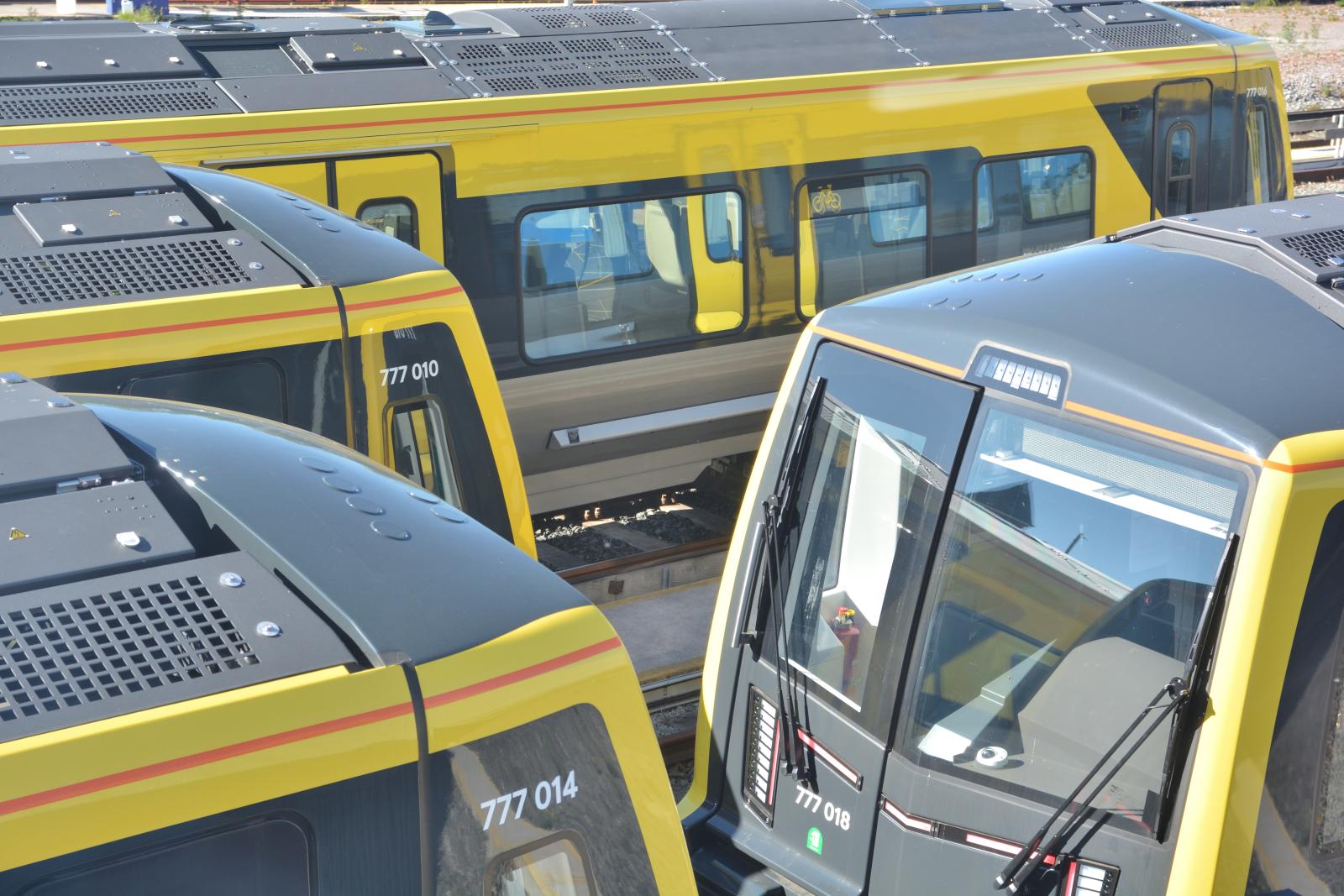Everything’s going yellow

There was something different about this normally routine journey from Liverpool Central to Kirkby. Not just that it was a new train (the first of the new generation) but the way people were reacting to it. There was genuine excitement from some of the regular passengers. And the staff looked pretty pleased too – chatting away to passengers like proud parents. ‘Designed by you, Owned by you’, read the digital display. In practical terms, designed in Merseyside means features like level access to the platform, tip-up seats to allow more luggage and pushchairs, spaces specifically designed for wheelchairs, prams and bikes, as well as USB and plug sockets under the seats. ‘Owned by you’ also resonates in a city whose port heritage gives it a sense of itself as very different from more stolid inland places.
The joy ride to Kirkby and back was an add on for me to a session we held for Urban Transport Group members to share approaches to franchising and to zero emission buses. A session where we found out more about how, as well as pushing the envelope of what a commuter train can be, Merseytravel is also doing the same for the bus. The new hydrogen bus project pushed the manufacturers to remove pain points and the designers to come up with something special – really special.
Even the bad boys and girls at the back of the bus now get their own individual seats – and like the rest of the seats they could teach long distance train operators a few things about what a comfortable seat feels like. Out go the excess of poles – creating less of a monkey cage feel. In comes accent lighting and bamboo flooring. To take some of the tension out of the issue there are also two spaces for wheelchair users. The whole shebang is of course hydrogen-powered and like the trains these are buses that will be ‘designed by you, owned by you’.
The new bus is also a statement of intent about franchising not being just a mechanical legal exercise to contractualise private operators. It’s about a fresh start for public transport; ditching the husk of the tired and expensive pretence that public transport is some kind of free market (something it long ago ceased to be in any meaningful way) and replacing it with what it should have been all along: a green and progressive civic utility. Symbolised by removing the hotchpotch of distant unloved corporate brands to give public transport back its dignity. Actualised by ensuring that more of the farepayers’ and ratepayers’ money stays in the city region to ensure that nothing is too good for the public transport user.
There’s more too. Turning the city region yellow can also help turn the city region green. There’s the potential to use locally generated power from a new Mersey barrage or from the chemicals industry down the Mersey; taking charge of transport land holdings can help realise development and meet local housing need. And all of this can help create good local jobs.
Meanwhile, on the other side of Chat Moss, in Greater Manchester, everything is also going yellow. All under the watchful eye of what is an inspired signing in Vernon Everitt (formerly of Transport for London) as transport commissioner. Taking on someone with experience of running a significant chunk of what is one of the biggest public transport shows on earth is what you need when you are looking to make Greater Manchester’s public transport look and feel more like what London already has.
With the roll out of publicly-controlled buses beginning in the autumn, Greater Manchester has been stepping things up on turning the local rail network yellow too. As well as fighting its way through the thickets of the rail reform process they are also looking to do a London Overground by zeroing in on six of the more self contained rail routes with a plan to turn them yellow and give them the full ‘Bee Network’ treatment (once all the buses are in-house).
In the shorter term Greater Manchester has also stepped up on tackling crime and harassment (and the fear of it) through making public transport the Eleventh District for policing. The Covid period led to public transport becoming a less supervised space and standards of behaviour notched downwards. ‘Always on’ comms is part of a much bigger picture of what Greater Manchester is doing on crime. But the comms helps highlight how action is being taken to counterbalance the drip drip of bad news in the local media.
All these positive local developments are taking place in the context of drifting national policy. As prime minister, Boris Johnson gave Andrew Gilligan (a true believer in active travel and buses) permission to ask for the stars, the moon and the sun in modal strategies from the Department for Transport – including the national bus strategy. The moon, the stars and the sun are all in those strategies – the budget to reach those lofty heavens wasn’t. Nor was the leeway for local transport authorities to move a muscle to achieve those strategies without Gilligan signing it off.
Gilligan also wanted his version of what London has achieved to happen everywhere at five times the speed – but with five times less autonomy than London has. Now he is no longer king for the day, the direction of transport policy has splintered and deteriorated into a quagmire of unresolved preferences and prejudices of individual ministers and advisors in different parts of government as the modal silos of the DfT fight over where the axe is going to fall as a result of the freezing of the DfT’s budget. This in turn has led to the latest twist and turn in the chaotic tale of funding for buses outside London, with yet another short term funding deal to kick the can down the road (and past the local elections). This forever funding crisis is debilitating for those who could be spending their time looking to the future of public transport and is masking an even more drastic and disorderly shrinkage of bus networks than was happening before Covid.
In effect, the sticking plaster of layering on short term additional funding packages to a broken system of bus funding is being pulled off a little bit at a time, instead of in one go. Death by a thousand cuts rather than a single hit – and, same as it ever was, it’s those with the least who are the losers.
Meanwhile, rail reform seems to have gone one step forward and one step back. Whilst the secretary of state has taken it out of the deep freeze, we are back to where we were in terms of the railways being open to all comers who want to fight it out on the most ‘commercial’ routes (commercial only because intercity infrastructure costs are being dumped on local and regional rail). So we are now, apparently, going to have a simpler fares structure (but with more fares competition between more operators), and a more integrated railway (but with more brands and operators who have more freedom to do what they want). And that’s all assuming everything doesn’t turn red after the next general election. Good luck with that.
Meanwhile, in Tyne and Wear, everything will soon be turning itself a brighter shade of yellow as the Metro gears up for a new fleet of ‘designed by you, owned by you’ Metro trains. It’s worth remembering that not only is the Tyne and Wear Metro arguably the only world class innovative transit system built in the UK in the 20th Century – it was also built in turbulent and unfavourable times for public transport. There’s a sense – as everything goes yellow in Merseyside and Greater Manchester – that the public sector’s natural inclination to innovate for the public good is finding an outlet in transport again.
Jonathan Bray is Director at the Urban Transport Group
The piece first appeared in Passenger Transport magazine.

